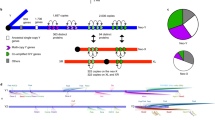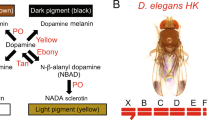Abstract
AN investigation of the manifestation of bristles and body colour in the mutation scute-8 of Drosophila melanogaster has shown that the characters dependent on the loci of yellow and achæte manifest themselves in a mosaic manner in this line (Noujdin, 1935). As the scute-8 chromosome contains an inversion with one of its points of breakage and reattachment close to these genes, which have thereby been brought into the neighbourhood of the bobbed locus (Serebrovsky and Kamshilov, public announcement, an unpublished MS. of 1930), it would seem that this mosaicism of scute-8 falls into the category of eversporting displacements, discovered by Muller (1930), that is, of chromosome rearrangements that entail a mosaic manifestation of genes located near the point of rearrangement. Among such eversporting displacements found by Muller are those producing the mottled alleles of white and those producing the Variegated alleles of brown. In the attack on the problem, raised by Muller, of the cause of this mosaic manifestation, a step forward was taken by Gowen and Gay (1933) in their finding that the presence of an extra Y-chromosome suppresses most of the mosaicism in the case of the mottled alleles of the white locus. This finding was confirmed, and was extended to the Variegated series (all probably connected with the brown eye colour locus) by Dubinin and Heptner (1934), Dobzhansky and Schultz (1934) and Glass (unpublished). We now find that an extra Y exerts a similar effect in suppressing most of the mosaicism of the yellow and achæte loci in the case of scute-8. This is additional evidence of the latter mosaics having a similar cause.
This is a preview of subscription content, access via your institution
Access options
Subscribe to this journal
Receive 51 print issues and online access
$199.00 per year
only $3.90 per issue
Buy this article
- Purchase on Springer Link
- Instant access to full article PDF
Prices may be subject to local taxes which are calculated during checkout
Similar content being viewed by others
Author information
Authors and Affiliations
Rights and permissions
About this article
Cite this article
NOUJDIN, N. Influence of the Y-Chromosome and of the Homologous Region of the X on Mosaicism in Drosophila. Nature 137, 319–320 (1936). https://doi.org/10.1038/137319b0
Issue Date:
DOI: https://doi.org/10.1038/137319b0
This article is cited by
-
A cytogenetic study of theY-chromosome ofDrosophila melanogaster
Journal of Genetics (1939)
-
Nucleic Acid Metabolism of the Chromosomes in Relation to Gene Reproduction
Nature (1938)
-
The nature of closedX-chromosomes inDrosophila melanogaster
Journal of Genetics (1937)
Comments
By submitting a comment you agree to abide by our Terms and Community Guidelines. If you find something abusive or that does not comply with our terms or guidelines please flag it as inappropriate.



